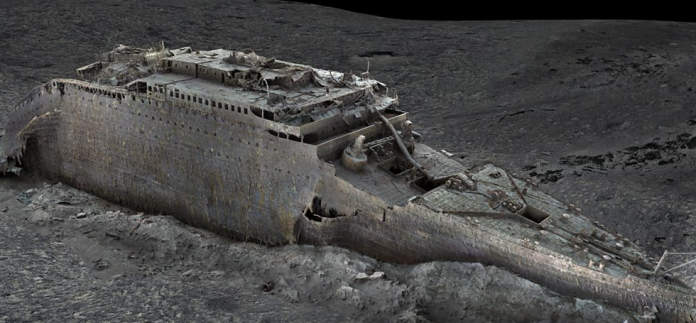A groundbreaking achievement has been made with the creation of the first complete digital scan of the Titanic wreckage, providing unprecedented details of the iconic shipwreck. Over 700,000 images were taken from various angles, allowing curious history enthusiasts to embark on a 3D tour of the ill-fated vessel.
This unique perspective showcases intricate features like the radio room and even the propeller’s serial number, making it the first unbiased and data-driven view of the entire Titanic wreckage.
The deep-sea mapping company Magellan Ltd and Atlantic Productions conducted the scan as part of a documentary project. Underwater robots, operated by specialist teams, meticulously surveyed the entire length and breadth of the wreck, which rests in two sections in the Atlantic Ocean off the coast of Canada.
The British Broadcasting Corporation (BBC) further enhanced the digital scan by superimposing it inside the London Stadium, offering an awe-inspiring display of the Titanic’s colossal scale.
The hope is that this digital scan will shed new light on the events that unfolded during the tragic night of April 14, 1912. Atlantic Productions CEO Andrew Geffen emphasized the significance of having access to every detail of the Titanic, enabling a comprehensive understanding of the disaster using scientific analysis. While it will take time to thoroughly examine all the collected information, new discoveries are expected to emerge on a weekly basis.
Historian Parks Stephenson explained that previous depictions of the Titanic wreck were influenced by human bias and artistic interpretation, resulting in potential inaccuracies in capturing its true scale.
However, the current digital model, created from pure data and incorporating artificial intelligence, offers an unbiased and objective representation of the wreckage. Stephenson believes this breakthrough marks a new phase for underwater forensic investigation and examination.
Resting at a depth of approximately 12,500 feet, approximately 370 nautical miles off the coast of Newfoundland, the Titanic lies in two main pieces, separated by around 2,000 feet. This remarkable digital scan allows researchers and enthusiasts alike to explore the ship’s remains in unprecedented detail, bringing us closer to understanding the historic tragedy that unfolded over a century ago.


